
|   |

|   |
 e-mail: leelakaverivenkat@gmail.com Dvi-Nethram - A two eyed vision of tradition in Natya Darshan Photos courtesy: Natya Darshan January 9, 2023 It was a two- eyed vision of tradition, in more ways than one, in Dvi-Nethram - The Vision of Parampara - that the onlooker was treated to, in Natya Darshan 2022, by Kartik Fine Arts, held at its customary venue of the Bharatiya Vidya Bhavan auditorium, Chennai. The subject conceived by advisor Prof. Sudharani Raghupathy aimed at highlighting India's dance culture, comprising what is referred to as 'the classical and the folk' - inclusive of art with a stylised vocabulary attained through generations of teacher-to-student transmission on the one hand, alongside the country's, less formal, myriad folk expressions among different sections of people- spontaneous and participatory - with degrees of stylisation too in some cases. Curated and conducted with involvement and panache by convenor Roja Kannan, senior Bharatanatyam exponent running Bharata Natyalaya, musician, teacher and choreographer, presently also the President of ABHAI, the festival also brought out tensions within a tradition, as it travels through the corridor of time. After the Awards function, Guru Smarananjali, a tribute to Bharatanatyam Guru Adyar Lakshman, made for a fitting start to the festival. As one of the earliest new age gurus, from outside the tradition, deeply influenced by the traditional teachers like Kittappa Pillai, late Guru Adyar K. Lakshman represents a true link in the great change in Bharatanatyam, as it travelled from temple and court to stage. Senior disciples of the late Guru, Bragha Bessel, Roja Kannan, Nityakalyani Vaidyanathan and Jayanthi Subramaniam, in that order, in solo appearances, performed the Pallavi, the Anupallavi and long Charanam of Subbarama Dikshitar's Padavarnam in Kamas ragam, "Entani ne delupudura". Art expression, with experience of age, becomes more potent - and to witness no-longer-young dancers, in their etched movements and abhinaya, with the Guru's stamp affirmed further in the teermanam interventions, addressing noble 'Vira, Vasanta, Tyagaraja' in the anguish of unfulfilled love, complaining of Manmatha's relentless attack with his flowered darts, was an experience in itself. Also featuring the next generation groomed in the same bani, the session ended with Tillana in Shankarabharanam presented by the students of these senior dancers. 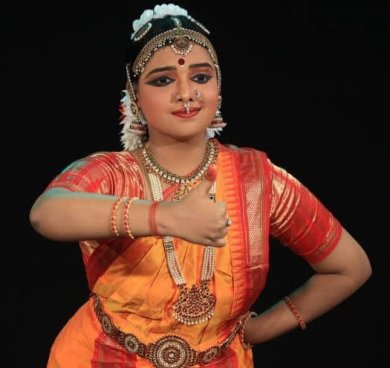 Charumathi Chandrasekaran Nattuvanars were not known for allowing the female members of the family take to dance. As the first female Bharatanatyam practitioner from within the Nattuvanar's family and the 9th direct descendent of the Tanjai Naalvar, who formulated the Margam repertoire of a Bharatanatyam performance, is Charumathi Chandrasekaran, granddaughter of K.P. Kittappa Pillai, and daughter and disciple of K.P.K. Chandrasekaran. Her neat recital had a quietude and dignity, the footwork in jatis articulating only some sounds in Kittappa Pillai's style. More internalisation, over time, should strengthen the interpretative aspect, while expressing lines like Moha lahiri konden Sami in the Todi varnam portraying the passion smitten nayika for Rajagopala, as also the subtleties in gesture and face in communicating a silent message to the loved one in a phrase like jaadai kaati azhaithal in the Usseni padam Netrandhi nerathile. 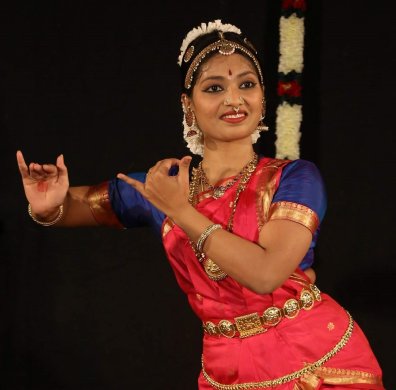 Sruthi Natanakumar 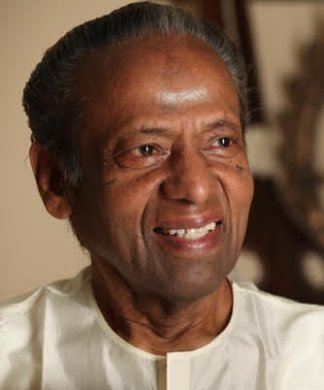 Guru Kalyanasundaram Pillai Yet another dancer hailing from the Nattuvanar family was Sruthi Natanakumar, disciple and great granddaughter of Vidwan Kuppiah Pillai of Sri Rajarajeswari Bharatha Natya Kala Mandir, Mumbai. On the paternal side, she is the great granddaughter of the renowned Thanjavur S. Kamalambal. It was heartwarming to see how with the senior most Kalyanasundaram Pillai given pride of place, with both Govindaraj Pillai's son and Mahalingam Pillai's son by his side, this Nattuvanar family has stuck together, keeping the family legacy alive. A PHD research student at the Cell for Indian Science and Technology in Sanskrit at IIT Bombay, Sruthi is also pursuing the practice of dance with diligence. Well trained, her presentation of the Todi varnam Danike takujanara (which was avidly performed by both Kuppiah Pillai and Mahalingam Pillai) followed by the padam Netrandhi nerathile in Usseni and Tillana in Hindolam to closing with a shlokam from Krishna Karnamritam, revealed a neat, very composed dancer. With the hereditary Devadasis disenfranchised by the Anti Devadasi act followed by the historic changes as the dance travelled from temple and court to the proscenium, the art form has survived the upheavals of history by drastically reinventing itself. Having missed the keynote address by dancer/scholar Lakshmi Viswanathan, whose references to the troubled history of Bharatanatyam would have been most revealing, for she is one who had her arangetram at the time of E. Krishna Iyer and learnt the art form under Guru Kanjivaram Ellappa, one presumed (which was later confirmed) that she would throw light on the part played by the Gurus also, as the custodians of the art form. 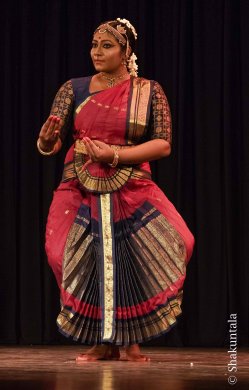 Nrithya Pillai Representing Guru Rajaratnam Pillai bani was his granddaughter Nrithya Pillai. She has in her art a certain conviction and communicative strength - clear from the presentation of the Kamas swarajati "Ma mohalahiri meerude," Namashivaya Pulavar’s composition which Guru Vazhuvoor Ramaiah Pillai had worked on. The nayika in the throes of passion for Kazhugumalai Murugan who is worshipped daily by Ettendiran, entreats the sakhi to catch the Lord when alone to convey her message of love. The padam "Arivenaiyya un andarangam ellam...," a Ghanam Krishnaiyar composition in ragam Attana portrays the khanditha accosting the husband for his two-faced behaviour and deceit. Fault finding, penny pinching and carping critic when with her, he is all praise, loving, and indulgent spender with the other woman. She also presented a javali in Bhairavi, "Ela radayane Kamini." 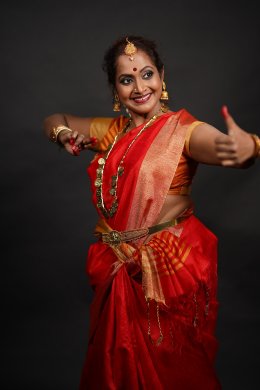 Dr. Yashoda Thakore Similarly involved in reclaiming the repertoire of the hereditary women dancers of the Telugu areas is acclaimed dancer Dr. Yashoda Thakore, who has authored the book Kaivalya - Joy in Yoga and Dance, apart from co-authoring the translation of the 13th century text Nritta Ratnavali. She presented excerpts from the Kalavantulu dance. While conscious of the pain these women suffered, she seems more hopeful of the present situation where dancers from the tradition have begun to get chances to perform. She mentioned with gratitude that this event, for the first time, had slots provided for recitals devoted entirely to the Devadasi repertoire. With men in the family connected with the Simhachalam Varadaraja temple, Yashoda came to know details about her family background only during her teens. As she talks of her 'Ammamma' who did not dance but played the violin, and names like Chinnagandham Kausalya and Pichhayamma roll off her tongue, you realise that from the side of both parents, she is a direct descendent of the Kalavantulu community working under the Peddapuram zamindars. When she went into the art form of the Kalavantulu, the story of these women opened a whole new world for one who had been training in Kuchipudi till then under Sobha Naidu and then Dr.Vempati Chinna Satyam. She even trained under Swapnasundari for some time. Speaking of the 'complex non-linear history of the Kalavantulu' she mentioned details like the Salam Daruvu in Kamboji presented in the Pratapa Ramaswami temple at Tanjore and elsewhere, with the God/King equation so central to this tradition. Presenting an excerpt from the Swarapallavi in Abheri, she referred to how rhythm is treated in the dance of these women with an accelerando rather than a doubling or trebling or laya resorted to. Daya leda... the purvangam (often done in the seated position) of the varnam in Navroz, Panthamela jesuvura bangarecha Bhoopala, as also the uttarangam were demonstrated. This abhinaya method of sitting down and establishing eye contact with the audience while performing creates an intimacy, as if the dancer is addressing one personally. She ended with the javali Inthiro vaani manasentha chinnaboyeno in Darbari ragam, adi talam. Talking of the 'hedonistic' approach in Devadasi art, and how a woman was described from head to toe, and how a phrase inviting the lover, saying this is the right moment (manchi samayamu) would be treated, Yashoda's relaxed ease in communicating through spoken word and abhinaya was appreciated. 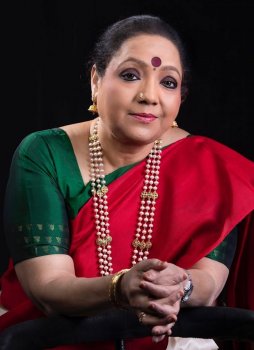 Usha RK Arts Consultant Usha RK, summing up the solo performances in her short talk, spoke of the threefold aim of all Paramparas as they travel through Time - Preservation, Perpetuation and Propagation. And this was the aim in nurturing all India bodies like the SNA. Dvi Nethra or a simultaneous look at both 'traditional and folk' has also been the watchword of governmental patronage. Paramparas are already looking forward and while the roots which lie in a long past must be kept strong, trying to keep them tethered to one time would not be possible. The creative wheel will keep rotating and from the hub, the spikes will show the spread in different directions. As for lines in a classical art, they form the basics. One masters them first and once this is firmly anchored in the body of the dancer, one can create as one wants with nobody to question. 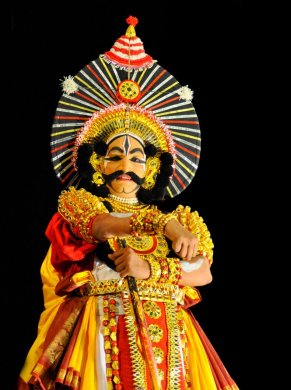 Yakshagana Traditions like Yakshagana, the traditional dance theatre of Karnataka, which used to be performed in open fields, have over the years acquired an undreamed of sophistication. The Prasanga by Yaksha Sinchana Trust led by Ravi Madodi from Bengaluru, showed how Yakshagana presentation in modern proscenium space has kept the traditional threads of this form like Poorvaranga, Oddolaga, and Yuddha Nruthya intact - while adding to the artistic appeal. Ravi Madodi is a software engineer, and so are many in the entire troupe - with Chinmaya, another software engineer also a maddale player, Krishnamurthy Thunga the chenda player who conducts the classes, Pradeep Madhyasta a mechanical engineer, Aditya Udupa also an engineer, Prof Shashiraj of BMS College of Engineering who gives lectures and presentations in State level workshops, Anand Rao Upadhyaya a bank worker, and above all a female Bhagavatar in the lead singer Chitkala Thunga, still doing her studies, with an unbelievable voice projection belting out a Kamboji, a Kanada, Mohanam or Todi, here is an organisation which is creating history. The Prasanga chosen starts with an appeal to 'Ranga' that he cannot possibly leave all the female devotees in Brindavan and vanish to Mathura. Kamsa's role was played by another software engineer, sporting a splendid crown, enacting the dream sequence he has had "Ena kandenu kanasa?" telling himself arrogantly "who has the courage to confront Kamsa?" He showed himself to be an excellent actor. Chaanoora and Mushtika entering Kamsa's court and getting eradicated and the battle, all concluding with the final Mangalam proved how after Shivaram Karanth changed the level of artistry with his work in Yakshagana, the art form has not looked back. One still remembers his abhinaya with two words 'Kapata Krishna' which he would show for twenty minutes with improvisations. 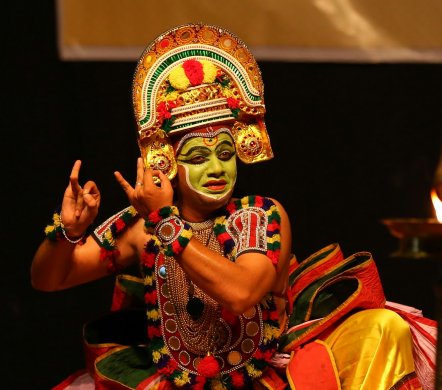 Ottanthullal On the spot creativity through improvisation with a ready wit, is best seen in Kerala's Ottanthullal, a tradition started as an alternative to Chakyar Koothu, by Kunchan Nambiar. The festival presented Kalamandalam Nandakumar and troupe, which performance was missed by this critic. From all accounts, it was an exhilarating experience. 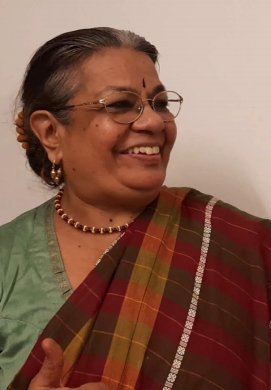 V.R. Devika 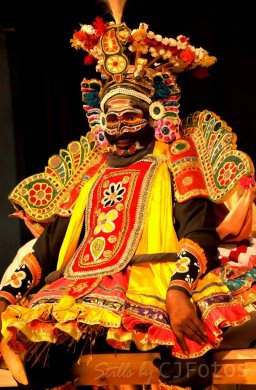 Therukoothu Giving her expert comments after the performance, V.R. Devika mentioned why and how art forms like Yakshagana had become so evolved with highly educated people taking to it, while a form like Therukoothu has remained as Bayalatta, still wedded to its ritualistic concerns. Draupadi's pardon is still sought. Audiences are as important as the performance for these traditions, for they add to the collective consciousness. Vesha, kala, patra are all important. A Therukoothu event makes use of the entire space of a village, while in a Yakshagana Prasanga, it is shrunk to the stage space. 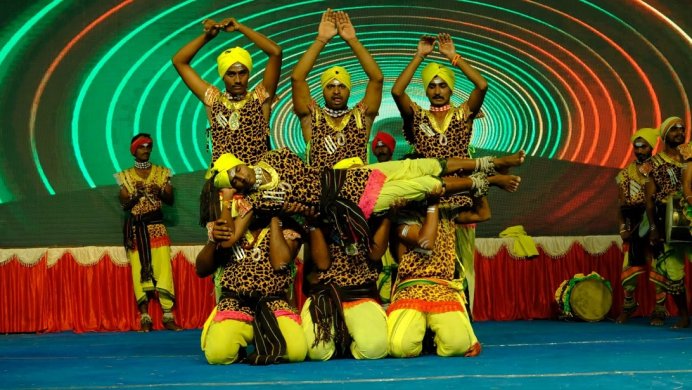 Oggu Dolu Vinyasam The other traditional theatre presented in the festival pertained to the Shaiva Sampradayam of Oggu Dolu Vinyasam, Telangana's popular folk theatre followed by the Kuruma and Golla communities. Eerlia Mahipal, an Undergraduate in Commerce and Business Administration, with his troupe presented Mallanna Katha and Beerappa Katha, where after rituals to Ganga and the serpent, the group of artistes each carrying a Dolu playing lustily on the drum rent the air with Pothu Raju and Shiva Shaktalu cries, while performing physical feats like pyramid poses, filling the entire space of the auditorium with throbbing energy. 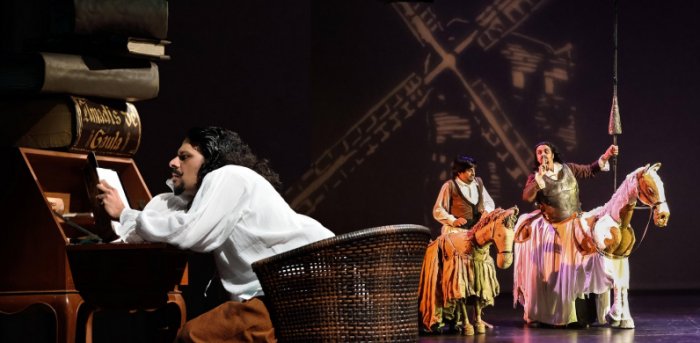 Don Quixote In a festival covering such a sweep in time from the past to the present, there were two contemporary productions by established Bharatanatyam artistes, the works encompassing poetry, music, dance and theatre, in a novel creation. The first of these, presented by Sahrdaya Repertory was Don Quixote - a 21st century stage adaptation of Miguel Cervantes Spanish 17th century classic by Sheejith Krishna, the inimitable choreographer, who sees in this hallucinating hero and his adventures, the imaginary world of every artiste, whose creativity after all, is fashioning a world away from reality. A hidalgo and member of the lowest nobility from La Mancha in Spain, Alonso Quijano, whose obsession for reading makes him hallucinate about being a knight engaged in chivalrous deeds, names himself Don Quixote, acquires a mace and sword, and sets off on his horse Rocinante (a barn nag well past his prime) on his adventures. He is accompanied by a side-kick he has chosen - a simple peasant Sancho Panza, a potbellied short man constantly trying to correct his master's outlandish fancies, to no avail. The way the choreographer has created the typical Spanish ambience, the stage properties of thick books of encyclopaedic size, the horse head representing Rocinante, scenes like that of the wind mills Don Quixote imagines are giant knights attacking, the costume designing and the way significant characters from the novel are conceived, is all nothing short of astonishing. Characters like Sancho Panza, the pastor, Dulcinea del Tobaco the hero nurses soft feelings for, the Barber (whose Mambrino, Don mistakes for a helmet) are so close to the book, and not least to be commended, is the way in which the Bharatanatyam vocabulary has been used to fit in every scene along with the most innovative music. But in all this an eye on the clock was totally lost sight of, it would seem. The dances go on and on, and while the work is long, even what is brilliant gets stretched to a point where its magic begins to fade. The best of the dancer/actors, and so close to the book, was undoubtedly the one as Sancho Panza. Droll and looking the part, he was brilliant. 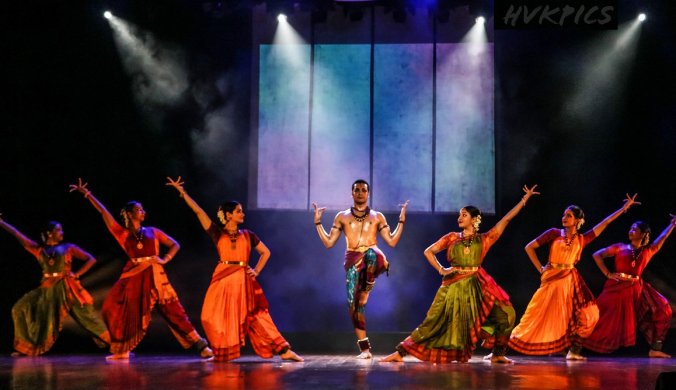 Tales from Bull and Tiger (photo: Harshavardhan) Hyderabad based Shankarananda Kalakshetra run by Dr. Ananda Shankar Jayant who inhabits with equal ease, it would seem, the different worlds of administration, academics and arts, performed Tales from Bull and Tiger built round the God of dance Shiva and his family. Giving physical form to and making visible, what is esoteric, Ananda Shankar's creative imagination has led to some excellent choreography - built on the musical landscape provided by Sathiraju Venumadhav with jatis by I.V. Renukaprasad. But what makes for the excellence of the production, is the set of twenty dancers, trained impeccably by Shankarananda Kalakshetra. Even the youngest as the mouse vahana of Ganesh, dances with infectious joy and involvement. And how smoothly the entire production moves, with Shiva (danced by guest dancer Mithun Shyam), partnered by a beautiful Parvati, surrounded by Ganesh and Kartikeya - each with the respective vahana. So the bull, the tiger, the mouse and the dancing peacock all have their parts - played to perfection. The literature is well known - a little Ganapati in Ganesh Mallari, Sharavanabhava bit as Muruga comes with his peacock, the magnificent Astutyarasyam description of the Himalayan abode where Shiva gets ready to be tied in wedlock with Parvati. Shankaracharya's Champeya gauraanga paints the tandav/lasya picture of how the couple represents complementarity in contrast - he as Jagat Pitra and she as Jagat Janani. Then comes the part where Shiva in solo glory dances Idadhu padam thooki in the Kanakasabha. Incorporated in his identity are the five elements of Prithvi, Jal, Vayu, Agni and Akash. The complete abstraction comes in the form of the Tillana performed in unison. Timed to perfection, with no loss of tempo from start to finish, the production, with lights by Gyandev Singh and digital design by Gunjan Ashtaputre, held the audience enthralled from start to finish. Mithun Shyam, a fine dancer, would have benefitted from this experience with Shankarananda Kalakshetra. Grateful thanks to convenor Roja Kannan and her advisors Dr. Sudharani Raghupathy and Chitra Visweswaran, for a well conducted 20th Natya Darshan! (Edited on Jan 23, 2023) (The opinions expressed in the article are those of the writer.)  Writing on the dance scene for the last forty years, Leela Venkataraman's incisive comments on performances of all dance forms, participation in dance discussions both in India and abroad, and as a regular contributor to Hindu Friday Review, journals like Sruti and Nartanam, makes her voice respected for its balanced critiquing. She is the author of several books like Indian Classical dance: Tradition in Transition, Classical Dance in India and Indian Classical dance: The Renaissance and Beyond. Response * Thank you, Leela Venkatramanji, for a detailed depiction of the events that took place at Natya Darshan. Few of us in the diasporic space, definitely learn about these events through write ups like this. Appreciate the time taken to do this. I am the founder and artistic director of Tiruchitrambalam School of dance. I completed my PhD in Performance Studies from the University of California, Davis. My research traces the aesthetic history of Bharatanatyam from the 1930s till 2020 analyzing it along the vectors of caste, class, gender, sexuality and religion. My research looks at these vectors alongside macro drivers like nationalism, globalization and neoliberalism while tracing this history. These are few of my comments on the review of the Dvi-Netram, the Natya Darshan festival of 2022, by Leela Venkatraman. I was intrigued by the choice of the title for the event - Dvi-Nethram. As explained by Venkatraman it was “aimed at highlighting India's dance culture, comprising what is referred to as 'the classical and the folk' - inclusive of art with a stylised vocabulary attained through generations of teacher-to-student transmission on the one hand, alongside the country's, less formal, myriad folk expressions among different sections of people- spontaneous and participatory - with degrees of stylisation too in some cases.” I was wondering if there was any talk or critical discussion in the festival itself about these complicated and loaded terms, ‘Folk’ and ‘Classical’? Indira Peterson in her introduction to the book, ‘Performing Pasts, Reinventing the Arts in Modern South India’ draws our attention to the constructed categories of ‘Folk’ and ‘Classical’ that were created during the process of colonialism, nationalism and Orientalism where certain forms were homogenized to be called ‘classical’ and others were marginalized to be called ‘folk.’ Many scholars like Lakshmi Subramaniam, Avanti Meduri, Janet O’Shea, Amanda Weidman, to name a few have written extensively about how art was reinvented with imagined traditions for nationalistic purposes. The ‘stylized vocabulary’ vs the ‘less formal’ dyad as framed by Venkataraman exposes an assumption of an implicit heirarchy in the ways in which we have been trained to view the ‘classical’ and ‘folk’ nomenclatures. Female hereditary practitioners danced in the courts, in the temples, in ritual and non-ritual contexts, in the homes of people. However when dance moved predominantly to a concert hall, a new ‘classical’ repertoire and therefore pedagogy was formalized. This, as we all know by now, left out many practices, specific pieces from the repertoire that came in the way of its classicalization. A syncretic dance scene that could be 'less formal' at times was rearranged selectively into the Bharatanatyam that we know today and is termed as 'classical.' I hope Lakshmi Viswanathan spoke to this and offered clarity in the naming and framing of this conference, which could be viewed as problematic if not nuanced with commensurate critical discourse. The next point that stood out to me in the review was a point that someone else had already commented upon before me, though anonymously. Venkataraman asked if it is “a crime if the ‘upper classes’ started learning from the Nattuvanars who had no problems in teaching whoever had the ability to learn their art.” It was a long battle with colonial modernity, missionary reform, anti-colonial nationalism led by English educated elites and the patriarchy of the newly forming nation that criminalized the life style of female hereditary practitioners and erased them from the public performing scene. The men in the community were left to teach women from upper caste families. They did not want the females from their families to dance because of the stigma created on them in popular culture between the late nineteenth and early twentieth century. They did not have a choice in the matter. Leela Samson mentions in her biography on Rukmini Arundale that Meenakshi Sundaram Pillai showed hesitation to teach Rukmini Arundale. He expressed his unwillingness by saying, “I do not feel inclined to teach. You are a rich lady, a society woman and from the brahmin community. Dance for you is only a pastime.” My dance teacher, Usha Srinivasan, a senior disciple of Nattuvanar, K N Dandayudapani Pillai, used to share with me that her teacher used to scoff at how the field was getting flooded with “Paapathis”, a casual slur for Brahmin women. There was clearly a resignation to the state of affairs. To gloss it as “no problem teaching whoever had the ability to learn their art” is lacking in nuance and critical perspective. Indian researchers like Amrit Srinivasan, and Lakshmi Subramanian were one of the foremost to talk about this discourse of caste and gender inequity in Indian performing arts. It is not a prerogative of diasporic researchers. But researchers like Davesh Soneji, Hari Krishnan, Indira Peterson, and Ananya Chatterjea continue to keep the topic present and active. It is uncomfortable. I am a second generation upper caste, Brahmin dancer myself. I have been practicing this dance as a teacher, and performer for over 3 decades now. I haven’t really stepped aside to give space for dancers from hereditary communities but I believe it is important to listen to Nrithya, allow myself to get uncomfortable, and see if that engenders some generative measures to reinforce equity in the dance filed. I could go on but the last point that I wanted to address was about the aesthetics of the dance itself. In my research I trace the aesthetic history of Bharatanatyam from the 1930s till 2020. When Bharatanatyam moved from the domain of female hereditary practitioners to upper caste female students the ideal dancing body also became less of the dark skinned, portly built and became more of the fair and slender built. The aesthetics of Bharatanatyam has been steadily moving towards athleticism for many decades now. While caste was the starting point of this shift in Bharatanatyam aesthetics today’s Bharatanatyam aesthetics is largely driven by the forces of globalization and neoliberal capitalism. The body of the Bharatanatyam dancer is a coveted currency in social media. Social media, an acute manifestation of neoliberalism, has catapulted this spectacularization of the Bharatanatyam body and the angularity of its aesthetics in public consciousness. Nrithya wants to push back on this move towards athleticism that she calls, “lines” and the commonly perceived ideal body of the Bharatanatyam dancer. Nrithya is taking a political stand on aesthetics and I applaud her for that stand. I have changed many of my pedagogical tools and ways of dancing and teaching to cater to the changing aesthetic orientation in Bharatanatyam but Nrithya is standing her ground to make a point. What we need today is aesthetic diversity- an appreciation, acceptance of different styles and presentation. I also wanted to point out that the word choice, 'rehabilitation' is again very problematic. Venkataraman might have said that in an attempt to argue for the devadasi dancers but it once again exposes an implicit bias that says these hereditary practitioners were erring individuals who needed rehabilitation. I would beg to understand what Venkataraman imagines that rehabilitation process might entail. History happened. We cannot undo it from the present. It is unfair to keep pointing fingers at the people in the past with our current sensibilities. We have the advantage of looking back at history but I believe it is important to do it with some charity. If at all the powerful could have done something in the early to mid-twentieth century, it would have been best to bring back hereditary practitioners and work actively to undo the stigma that was created on them. But they were too close to that discourse of stigma to undo it then. Scholar dancer Yashoda Thakore's fight is to bring back that respectability to hereditary dancers so that more from that tradition will take to dancing. Thus, I appeal to Venkataraman to use caution when using words like 'rehabilitation' with respect to hereditary practitioners which triggers years of trauma and violence that has been endured by that community. We have work to do. Let's take the essence of Pillai's plea and not get turned off by her candid remarks. Then we end up once again throwing the baby with the bath water. These are topics that need longer, friendly and an open-minded discussion where we could clarify our positions, explain our word choices, accept feedback and educate each other. I would love to have a discussion with anyone who wants to take me up on any of the above points that I have discussed. - Deepa Mahadevan (January 12, 2023 / artistscholardeepa@gmail.com) Post your comments Pl provide your name and email id along with your comment. All appropriate comments posted with name and email id in the blog will also be featured in the site. |